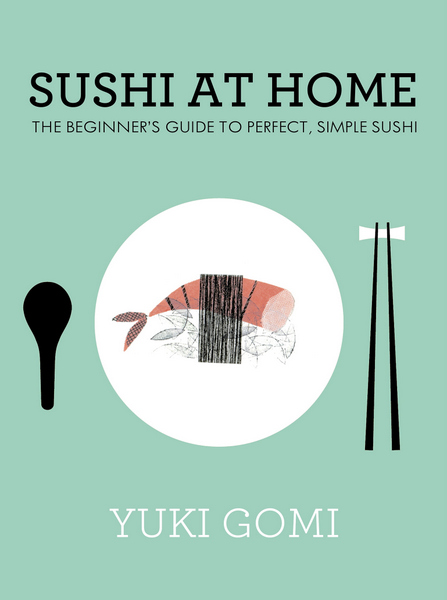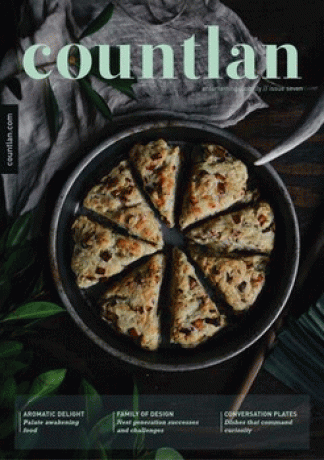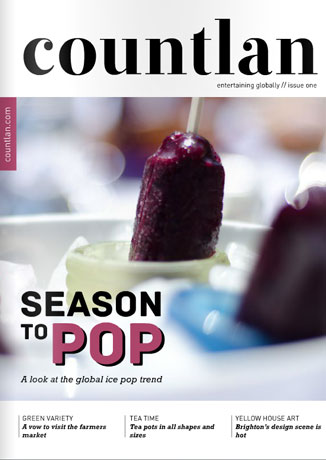
On Presenting Sushi
Written By: Yuki Gomi
If you have mastered sushi rice and have perfected your rolling technique, you will no doubt be wondering how best to present and serve sushi to your guests. In Japan, we say that you also eat with your eyes, so presentation is as important as how a dish tastes. Arranging sushi is an enjoyable part of the process and it doesn’t need to be too complicated.
Less is more, both in terms of presentation and portion size. There is no need to completely fill the plate. You can re-stock later. I love to present a few pieces of sushi on one dish, leaving space to balance the layout. Choose different types of plates, or tiles and practice by placing all of the sushi to one side with equal proportions of empty space.
I often make reference to the seasons on the plate, as many Japanese art forms do; the Haiku for example. You could add some edible flowers from the garden to dress the table or platter. We sometimes go as far as deep frying momiji – edible maple leaves; the deep reds refer to the seasonal falling leaves in autumn. Try working with contrasting colours that accentuate those found in the sushi itself.
There is a Japanese term called ‘Wabi-Sabi’ which is very useful in terms of understanding the Japanese aesthetic. It is also the key to a successful, enjoyable presentation of a dish. Wabi Sabi is a poetic, complex term, which describes the beauty of transience and at times, the imperfection found in nature. So what does this mean when presenting sushi? Don’t be afraid to scatter or cluster rolls rather than lining them up in neat rows. There is no need for exact symmetry. Present naturally and take pleasure in those small mistakes!
INTERVIEW: Yuki Gomi, Chef, Teacher Author of Sushi at Home, {London}
01 Where are you based and how many years have you been cooking?
I am based in London, but teach people all around the UK and in Europe. Since qualifying as a professional chef in Chicago, I have been cooking for over 15 years; but this doesn’t include those early years of core training in my mum’s kitchen back in Yamanashi, Japan.
02 What got you interested in cooking in the first place?
In Japan, we surround ourselves with the discussion of food, the origin of ingredients and how certain dishes can help your health. It goes without saying that all of this should be delicious and healthy and for me it was natural to learn about this approach from my mother; as she is a fantastic cook.
03 Why is there an apprehension towards cooking Japanese cuisine at home?
Many people are scared off by the idea of trying Japanese food at home, probably because of the popularity of the higher end dishes such as sashimi and sushi. However, as a genre, it has so many different types from ultra-high-end Kaiseki in Kyoto, to street foods such as ramen or curry and simple grilled fish with tempura made at home. What is consistent throughout all of these styles is a dedication and attention to detail that is evident in the work of a Kaiseki chef in Kyoto, or the way a Mother prepares her child’s Bento box before school. With a few simple tricks, Japanese cooking is really approachable and very easy to cook at home. It is not laborious, does not take too long and can become a fast food, easy even after a hard day at work.
Why do you think that is?
It is a mindset! There are some key methods to learn, but the real secrets lie in choosing good, fresh ingredients and having a fascination for them. Attention to detail is a must, a simple Miso soup takes only ten minutes to make, once the technique is mastered.
04 Why did you decided to teach?
I love talking about food with the people I meet, from the people I was meeting here; it became apparent that there were many myths about Japanese cooking abroad. I want to teach people the techniques, to show them it is easy to create delicious Japanese dishes. I also love the challenge of using locally available products here in the UK, or wherever I happen to be, as alternatives to the original recipe.
05 Have you seen the film, Jiro Dreams of Sushi?
Embarrassingly; no! I think I better download it now and get back to you! However he is someone I am very familiar with and admire greatly.
06 Do you entertain at home?
Yes as often as possible, the dishes I cook are not exclusively Japanese, however it is certainly where they find their origin in terms of delicacy and flavour. I love finding parallels to Japanese cooking in other cuisines, in the big kitchens of Chicago I worked with teams of Mexicans, so this has been a strong influence. Travelling in Europe to Italy or Spain, where there is a similar obsession with fresh, seasonal ingredients often inspires the dishes I like to make for guests. Alongside, on the table I have fresh flowers from my garden, pottery made by Mum and random tableware from travels in Asia and Europe.
07 Every aspiring Japanese home cook must have…..
A good hair drier with a cold setting for cooling the sushi rice down and to look great when the guests arrive.

Photo Source: Keiko Oikawa
08 What have you learned from teaching others how to make Japanese food?
That architects and surgeons roll very neat and good looking sushi.
09 What is next for you?
I’d like to encourage some of that Japanese passion and fascination for the source, role and purpose of ingredients in people here in Europe/USA through writing, presenting and teaching.
10 Where was your most inspiring Japanese meal?
It was at fisherman’s restaurant in Tsukiji market. Nothing posh about the design of the restaurant but it was an amazing simple meal from the market, at 7am fresh off the flight from London.
Get Rolling- Sushi Recipes To Try
- The Krooked Spoon: Marinated Salmon and Quinoa Maki Rolls
- Blog Exquisit: Sushi with Stratwberry and Mango
- Just One Cookbook: Scallop Sushi
- Sailing Fork: Chocolate Funky Monkey Roll
- Lady and Pups: Spicy Salmon Mini Hand Rolls
- Wagon Cafe: Pressed Sushi with Pickled Salmon
- Cooking with B.S.: Breakfast Sushi











